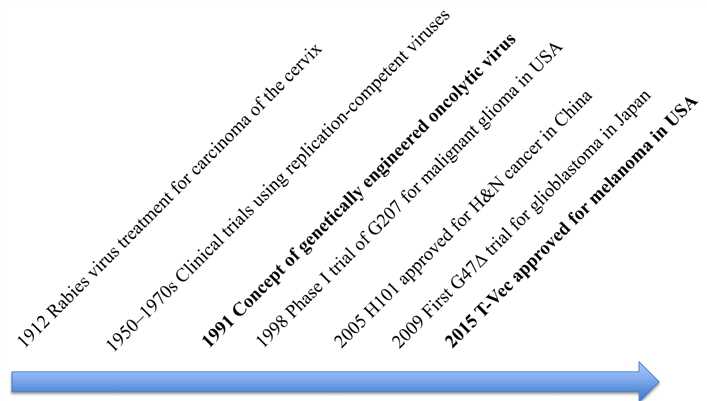Serpin-1-based Tumor Selectivity Enhancement of Oncolytic Vaccinia Virus
Overview of Vaccinia Virus and Serpin-1
The best-characterized poxviruses, of which vaccinia virus is the prototype, belong to the orthopoxvirus genus. Although the host ranges of orthopoxvirus are relatively narrow in nature, they are quite broad in cultured cells and laboratory animals. The viral serine protease inhibitor (serpin)-1 (SPI-1) gene was found to be necessary for the replication of the rabbitpox virus in human lung A549 and pig kidney 15 cell lines, and subsequent studies suggested that its role in these cells was to prevent apoptosis.
 Fig.1
Milestones of oncolytic virus therapy development. (Fukuhara, 2016)
Fig.1
Milestones of oncolytic virus therapy development. (Fukuhara, 2016)
Introduction of Serpin-1
SPI-1 is one of the three related orthopoxvirus genes with sequence motifs that place them in the serpin superfamily. Serpins also are present in the myxoma virus and a murine gammaherpesvirus. Typically, serpins irreversibly bind via their reactive center loop to serine proteases and inhibit the activity of the latter. Serpins have multiple roles and some are involved in the regulation of immune and inflammatory responses and cell death. The best-characterized orthopoxvirus serpin is SPI-2, also known as CrmA, which efficiently inhibits aspartic acid-specific cysteine proteases (caspases) and less efficiently inhibits the aspartic acid-specific serine protease granzyme B and prevents IL1-b formation and cytokine-induced apoptosis. The SPI-1 gene encodes a protein that is 44% identical to SPI-2 but with a different reactive center. Both proteins are expressed early in infection and reside intracellularly. SPI-1 can act synergistically with SPI-2 to block granule-mediated cell killing pathways.
Deletion of Serpin-1 in Vaccinia Virus
In a previous study, a vaccinia virus ΔSPI-1 mutant was constructed and found to replicate nearly 2 logs less efficiently than wild-type virus in human A549 cells, similar to what had been found for a rabbitpox virus ΔSPI-1 mutant. The host range defect was specific because the vaccinia virus ΔSPI-1 mutant replicated normally in BS-C-1 and other cell lines and an independently isolated mutant had the same phenotype. By contrast, vaccinia virus with a deletion of the nearby SPI-2 gene, had no replication defect in A549 cells. Although nuclear invagination and chromatin condensation were noted at late times in some ΔSPI-1-infected A549 cells, other classical morphological features of apoptosis were not apparent. Also, none of the examined biochemical correlates of apoptosis, e.g., DNA fragmentation or cleavage of PARP, NuMA, or caspase-3 were associated with the host range defect. Indeed, the ΔSPI-1 mutant effectively prevented TNF-induced apoptosis of A549 cells, whereas a ΔSPI-2 mutant did not. It remains possible that SPI-1 interferes with other apoptotic pathways in A549 cells that were not examined.
Services at Creative Biolabs

With rich experience and strong foundations, Creative Biolabs has established a great reputation in providing one-stop oncolytic virus enhancement services. We have more than 10 years of experience focusing on oncolytic virus enhancement and gradually developed a comprehensive technology platform offering various oncolytic virus enhancement services including serpin-1-based enhancing tumor selectivity services.
Reference
- Fukuhara, H.;et al. Oncolytic virus therapy: A new era of cancer treatment at dawn. Cancer Sci. 2016, 107(10): 1373-137
